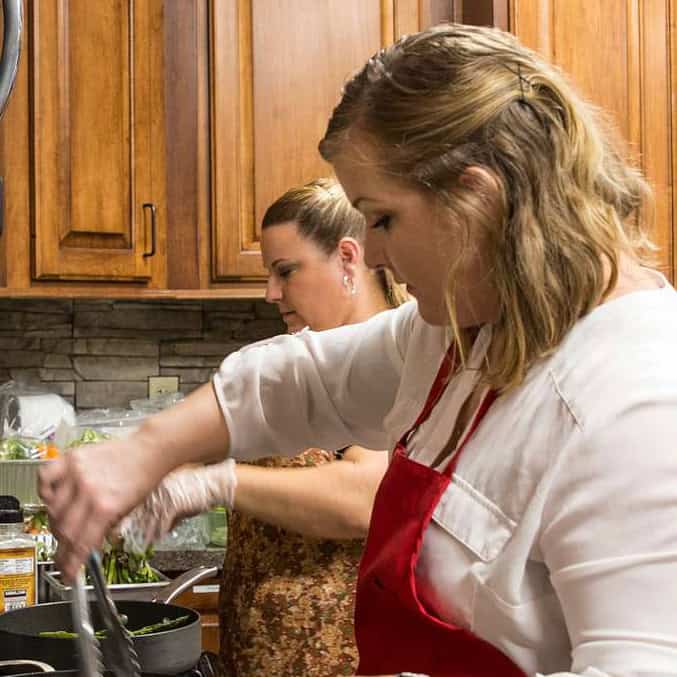Think for a moment about how you do your grocery shopping. Do you go during the day or at night? Are you alone or wrangling two kids? Is it a weekly event or an every-other-day outing?
Now think about the times when you’ve spent more money than you thought you would. When does that typically happen? What foods did you buy that you didn’t plan on buying?
Since grocery shopping is necessary to creating healthy, home-cooked meals, it’s emotionally and financially worth it to consider how we can shop the grocery store smarter. Here are a few ideas to get you going.
Take Inventory
Once a month, it’s a good idea to clean out your refrigerator and reorganize your pantry. “What does that have to do with grocery shopping?” you wonder. Knowing what you have at home makes you less likely to buy items at the store you don’t actually need. Yes, it’s true we should all have breadcrumbs on hand, but have you bought breadcrumbs thinking you might need them, only to arrive home and find two unopened containers already on the shelf? Exactly.
Eat Before You Shop
Being hungry in a grocery store is like sending a kid into a toy store with her own credit card. Not a good idea. Whenever possible, try to shop after you’ve eaten a filling meal. At the very least, have a granola bar in the car; that way, you’ll have more self-control when walking buy those beautiful trays of donuts.
Make a List – and Stick to It
We’ve all done it. We go in for three items and (in a daze) walk out of the store pushing a cart with about 50 items. What the heck just happened? One of two things: your list wasn’t well-planned or you made a lot of impulse purchases. Take time before going to the store to make a thoughtful list that includes all of the items you’ll need to make meals for the next few days, plus any staples you’ve run out of. Also consider items you eat for snacks like fruits, vegetables, chips, and yogurt. To help yourself refrain from impulse buys, place a basket inside your cart. Anything you grab that wasn’t on your list should go into the basket. Then, before checking out, place the items you’ve decided you really need into the main part of your cart and hand the unnecessary items in the basket right to the cashier with a simple explanation that you realized you don’t need those items.
Shop the Parameter
Picture your local grocery store. It’s likely that the produce, dairy, meat, and baked goods sections form the perimeter of the store, while the packaged foods constitute the center. Fresh fruits and vegetables are the healthiest ingredients for meals, and they are often less expensive than so-called “healthy” processed foods, so the produce section is a great place to start your shopping. Here again, planning is key. You don’t want to throw away avocadoes because you bought four when you only needed two, and you don’t want to have a bag full of onions sitting around for months either. While in the produce section, you can buy fresh herbs to use during the week and you can dry the extras to use next time.
Just Ask
There’s a reason why grocery stores have people working in different departments, and it’s not just to show you where to find the ground beef. Many grocery store departments offer wonderful services to its shoppers. In the seafood section, you can not only get fish cut to your specifications, but many will steam and season shrimp for you. In the meat section, you can often place an order if you want to buy a cut that’s on sale but you don’t need it until later in the week. Many butchers will also cut, trim, or grind meat for you, which means you end up with fresher meat for less cost. In the bakery section, don’t be dissuaded by a whole loaf of bread; simply ask for it to be sliced. (This is especially helpful if you want to buy a whole loaf of French or sourdough bread for making crostinis.) Finally, to add flair to your flowers, ask the floral department for some free greenery, which will keep your greens in your pocket.
Be a Frequent Flyer
While preparing your shopping list or meal plan, use your grocery store’s weekly flyer to help you determine the best meals for your money. Often, stores will follow seasonal trends, so use this to your advantage and make gobs of gourd soup in the fall and freeze the extras for later in the year. Also be sure to clip the coupons you can use and combine them with any manufacturer’s coupons. Some stores will even match competitor coupons or sales, so ask about your grocery store’s policy to see if you can take advantage of those perks. Finally, highlight those items on your list for which you have a coupon or clip the coupons to the list so you don’t forget to use them at checkout.

Hello, I am Cristy. I love cooking but what I love most is keeping my kitchen tools and appliances top notch. I enjoy writing about everything I have learned around the kitchen. I believe that keeping your kitchen tools well cleaned and maintained produces the best dishes and drinks. Besides writing and cooking I enjoy traveling, camping, hiking and music.
